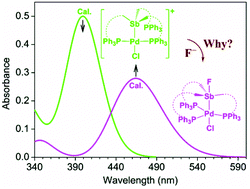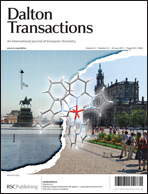Systematic DFT calculations were carried out on a series of heterodinuclear complexes [(o-(Ph2P)C6H4)3M1M2Cl]+ (M1 = As, Sb, or Bi; M2 = Pd or Pt) to investigate the mechanism of colorimetric sensing function for the fluoride anion. The fluoride anion binds with the M1 center to afford a hypervalent M1 species with large stabilization energy. For instance, the stabilization energy by the fluoride adduct formation is −15.5 kcal mol−1 for 3 (M1 = Sb; M2 = Pd) and −16.2 kcal mol−1 for 6 (M1 = Sb; M2 = Pt), where a negative value represents stabilization. Interestingly, the allosteric coordination of the third phosphine with the M2 center is induced by the fluoride adduct formation. For chloride, bromide, and thiocyanide anions, the binding energies are positive (∼4.5 kcal mol−1), and the allosteric coordination does not occur. The allosteric coordination plays a crucial role in the absorption spectrum change induced by the fluoride adduct formation. For instance, the fluoride adduct formation quenches the absorption band of 3 around 400 nm and newly exhibits two absorption peaks at longer wavelength, 475 and 451 nm. These two peaks are assigned to ligand-field transitions (dxy → dz2 and dx2−y2 → dz2) including metal-to-ligand charge transfer character. We discussed the reasons why the allosteric coordination can occur only in the fluoride adduct and induces these two absorptions in the longer wavelength region. In addition, the Bi–Pd combination is also recommended for a fluoride sensing material, while the Sb–Pt combination is recommended for cyanide sensing.

You have access to this article
 Please wait while we load your content...
Something went wrong. Try again?
Please wait while we load your content...
Something went wrong. Try again?


 Please wait while we load your content...
Please wait while we load your content...